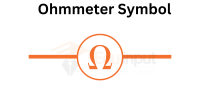| www.tmatlantic.com
Test & Soldering Equipment On-line Store |
|
D.E.V.I.C.E. (Wiki)Calculators Services |
|||||
Filter by first letter
|
Ohmmeter
Ohmmeter - a device for measuring electrical resistance to direct current in Ohms. The ohmmeter scale is calibrated in Ohms, kilo-Ohms or mega-Ohms in accordance with the measurement limits of the device.
An ohmmeter is connected to an electrical circuit parallel to the section of the electrical circuit or electronic component that is being measured. The most common measurements are carried out for resistors and electrical circuits. Pic.1 An example of connecting an ohmmeter to a circuit using a conventional (2-wire) circuit. (upcoming) When measuring small resistances, it is important to consider the resistance of the test leads. To improve the accuracy of such measurements, a 4-wire measurement circuit is used. This 4-wire measurement circuit is necessarily used in milliohmmeters. Pic.2 An example of connecting a milliohmmeter to a circuit (upcoming) Functionally, an ohmmeter can be made based on measuring the current flowing through the resistor being measured or based on measuring the voltage drop across the measured resistance. Schemes using a measuring bridge are also used. An ohmmeter built according to a circuit for measuring current through a measured resistor usually has a very uneven scale (stretched on one side and strongly compressed on the other). An ohmmeter built according to a circuit for measuring voltage across a measured resistor is the most widespread in modern digital ohmmeters and multimeters. This circuit provides good measurement results and a linear ohmmeter scale. An ohmmeter built on the basis of a measuring bridge provides the most accurate measurement results. An ohmmeter should also be considered as a mode of operation of a multimeter. |
Site mapPrivacy policyTerms of Use & Store PoliciesHow to BuyShippingPayment




|

























